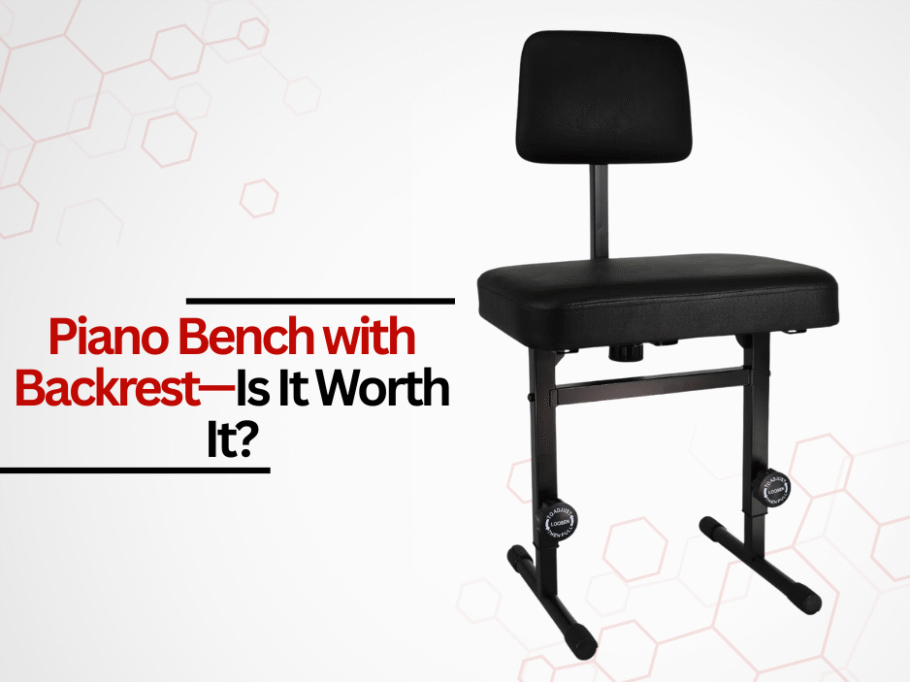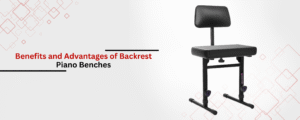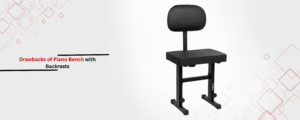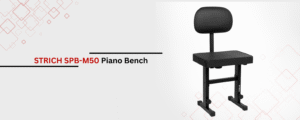Every pianist is familiar with the back-breaking, backless benches that offer very little support and comfort for the hours of practice they put in. With recent advancements, ergonomic designs with backrests have started becoming popular. In this article, we will help you look at the pros and cons of a piano bench with a backrest so you can make a fully informed decision.
To know more, Read: Cheap vs. Expensive Keyboard Benches: Is Price a Factor?
The Case For Backrests: Benefits and Advantages
Redefined Ergonomic Support and Posture Alignment:
Piano benches with backrests help with the alignment of your spine and reinforce proper posture. Backrests limit slouching, which too many people do during prolonged work sessions. The most expensive models offer adjustable backrests that can be set at different angles and heights specific to each user’s body.
Reduction in Musculoskeletal Strain:
Due to slouching, backrests easily reduce the amount of pressure on the hips and lower back. This is especially beneficial for many players where the hips and lower back are burdened with repositioning spinal parts. Supported seating can reduce muscle fatigue by up to 30%, according to the research.
Additional Comfort During Extended Sessions:
Seats and padded backrests improve comfort during long rehearsals or performances. This comfort is further enhanced with high-density foam or memory foam used in ergonomic piano benches.
Other Uses Beyond Piano:
In addition to casual seating, the benches with backrests serve as additional seating in home studios and are therefore useful in multifunctional areas.
Drawbacks of Backrest Benches: Factors to Weigh and Restrictions
Limited Movement:
Dynamic movements in jazz or contemporary music may be difficult due to fixed upper body movement with a backrest. Utilizing forward-leaning expressive techniques also becomes difficult.
Portability and Space Limitations:
These backrests increase bulk, adding to less spatial efficiency with these benches, which is a concern for compact spaces or touring musicians. They do exist in foldable forms but they are often weak.
Increased Price:
Due to additional backrests and ergonomic engineering, Backrest-equipped benches typically cost around 20 to 40% more than backless models.
Aesthetic Compromises:
The minimalistic appeal of acoustic pianos, usually paired with benches, is claimed to be disrupted by backrests.
Backrest vs Backless: An Illustrative Comparison
1. Support vs. Flexibility:
- Backless Benches: With backless benches, you have unrestricted movement, which is favorable for quick transitioning postures.
- Backrest Benches: With backrest benches, they prioritize spinal well-being and are great for classical training or extended practice sessions.
2. Adjustability
- Backless: Usually have only height adjustments.
- With Backrest: Might offer lumbar tilt, height, and depth adjustments.
3. Weight and Portability
- Backless: Lightweight (10–20 lbs) and portable.
- With Backrest: Heavier (25–40 lbs) and bulkier, intended for stationary setups.
Best Piano Benches to Help ease Back Pain
5 Core PNB B-Rest Piano Bench:
The 5 Core PNB B-REST piano bench offers a thick padded cushion and a removable backrest. The height adjustability ranges from “17.5 to 22 with a weight of 445 lbs, ensuring durability. Along with that, the backrest provides added support, ensuring optimal playing posture and comfort during long practice sessions.
Pros:
- The soft, 3-inch-thick cushion that offers exceptional comfort and support, ensuring no fatigue during long practice sessions.
- Multiple height adjustments from “17.5 to “22 inches promote ergonomic posture and comfort for different users.
- Backrest offers extra support and enhances comfort.
- Robust metal alloy frame promotes longevity and durability.
- The non-slip rubber feet increase stability.
- Easy assembly for a quick setup.
Cons:
- Overall, I liked the piano bench. I was expecting 3 days of delivery, but I received it after 4 days, which is negligible.
Looking for lasting comfort and support? Discover our backrest piano benches—perfect for long practice sessions and reducing back strain for every pianist.
Don’t miss exclusive offers—upgrade to a backrest piano bench for ergonomic seating and secure, stylish support at your piano.
Liquid MS108x Stand Bench:
The Liquid MS108X Piano Bench comes with a thick 3-inch cushion, a wide backrest with spongy support, and adjustable elevation of “17.5–22 inches. Furthermore, the non-slip rubber feet increase steadiness.
Pros:
- 3-inch-thick cushion padding provides superior comfort, reducing pressure during extended playing sessions.
- Full back support using a wide backrest.
- Height adjustable for both kids and adults from 17.5 to 22 inches.
- Heavy-duty metals support over 275 pounds.
Cons:
- Restricts movement while playing the piano.
- Reduces ease of mobile travel.
- Cannot fit in small spaced areas due to its bulkier design.
Strich SPB-M50 Piano Bench:
The Strich SPBM50 piano bench offers adjustable height, a padded seat, and a removable backrest for additional comfort. As a musician’s piano bench, it provides comfort and durability for long practices.
Pros:
- Multiple Height adjustability (19” to 24”) accommodates different users and playing styles.
- Removable backrest aids comfort and support during prolonged practice sessions.
- The cushioned seat helps reduce pressure and provides comfort.
- Durable solid frame ensures long-lasting sturdiness.
- Affordable price range compared to other models with backrest support.
Cons:
- Restrictive nature of the backrest may be an issue for some users.
- Setting up assembly may take time to complete.
- Limited range of adjustability may not accommodate extremely tall users.
- No lumbar support or memory foam cushions.
- Bulky design limits compact space or ease of transport.
Conclusion
Investing in a piano bench with a backrest comes down to the specific preferences of the user, weighing ergonomic advantage against mobility and cost. Support that enhances the user’s comfort can completely change practice sessions and help reduce long-term strain for those who prioritize comfort. For active performers or performers in cramped spaces, backless benches are still the more practical option.
Brands such as 5 Core, Strich and Liquid Stands all have different traditional and modern options available. No matter whether a pianist chooses to go for lumbar support or a more minimalistic approach, every decision represents the individual health, style and practicality of a pianist.






